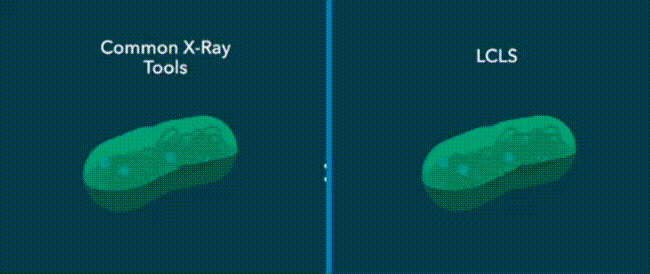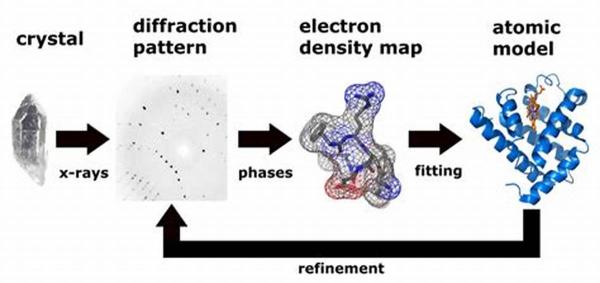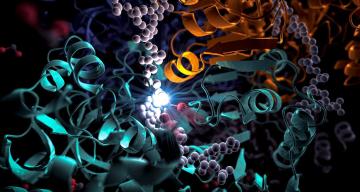Serial Femtosecond Crystallography
Outrunning radiation damage
Measuring high-resolution structural information requires a probe with similar wavelengths (or shorter) to the characteristics of interest. In structural biology, these length scales are the bond distances in matter (~ 1.5 Å = 0.15 nm) and necessitate the use of high-energy X-rays, electrons, or neutrons.
Unfortunately, using X-rays, electrons, and neutrons for imaging causes radiation damage to the biological samples, which is related to the dose (absorbed energy) of the probe used.
The high-resolution data that is used for distinguishing individual atoms in a biological structure has a weak signal compared to the noisy background. Measuring this kind of structural information therefore requires a longer exposure or higher X-ray dose). As a consequence, structural biology experiments are a race between illuminating the sample with enough probes to measure high-resolution data before the radiation damage destroys or distorts the structure that is being studied!
At X-ray free electron lasers (XFELs) such as LCLS, the race between data acquisition and accumulation of radiation damage is approached in a unique way: the full X-ray dose is delivered in extremely short bursts. In this way, the structural information can be collected before most of the radiation damage has time to take place, also known as the “diffraction before destruction” principle.

The ability to deliver ~1013 photons within a 40 fs (40 x 10-15 s) X-ray pulse is what makes the LCLS such a powerful tool for structural biology. For comparison, typical synchrotron light sources take 1 second to deliver the same 1013 photons! As a result, electron density maps of biomolecules determined at synchrotrons will show varying degrees of radiation damage. In contrast, the ultrafast LCLS X-ray pulses deliver data on the object’s structure before most of the radiation damage had the time to propagate.
Room temperature measurements on microcrystals
At synchrotron light sources, cryogenic cooling is used to slow down the effects of radiation-induced damage. Thanks to the diffraction before destruction principle, there is no need to mitigate the conventional X-ray radiation damage at LCLS. As a result, structures of biomolecules can be determined at room temperature.
It was demonstrated in 2012 that room temperature structures can be determined using the intense X-ray pulses of LCLS. Moreover, this study showed that the high intensity of the XFEL pulse makes it possible to obtain high-resolution structures from micro-crystals, which are often too small to study at synchrotron light sources. LCLS can therefore be used to study the structure of biomolecules that are often difficult to crystallize, such as membrane proteins and large protein complexes.
Finally, the ability to solve structures at room temperature also paves the way for studying dynamics in biological systems. By introducing stimuli to perturb the biomolecules in the crystals (for example by mixing enzyme crystals with a substrate), you can follow the time course of a biological reaction. Such measurements are not possible at cryogenic temperatures.
Serial crystallography
To arrive at an underlying structure using traditional macromolecular crystallography, the intensities of Bragg reflections generated from the diffraction of a crystal must be measured and converted into structure factors. These structure factors are then used to calculate the electron density map using a Fourier transform, which reveals the macromolecular structure.
It is important to note that the intensity of each unique Bragg peak must be integrated. A single diffraction pattern contains only partial reflections and is thus not sufficient for measuring the integrated intensity of the different Bragg peaks.
In conventional crystallography, the crystal is rotated relative to the X-ray beam allowing multiple partial intensities of each Bragg peak to be sampled. The partial intensities are then integrated and converted into structure factors.

At the XFEL, the peak intensity of the X-ray pulse destroys the crystal after the measurement, which means taking multiple measurements on a single crystal is challenging to impossible. A single measurement on a crystal will not be sufficient to determine the structure of the biomolecule, because only partial intensities of a few Bragg peaks are recorded. In order to reconstruct an electron density map for the crystallized molecule, the integrated Bragg peak intensities for all the unique reflections still need to be measured.
This led to the development of the serial femtosecond crystallography (SFX) technique, in which the integrated data is calculated from single diffraction patterns of thousands of single crystals. Each single diffraction pattern is indexed and the partial intensities from thousands to millions of independent measurements are integrated to determine the structure factors.
Consequently, new sample delivery methods have been developed to deliver thousands of crystals into the X-ray interaction region in a serial fashion. The serial femtosecond crystallography field has also led to the development of novel data analysis methods that allow for the accurate determination of the structure factors from millions of random single-crystal diffraction snapshots. The SFX technique has since been adopted for use at synchrotrons as well, which led to the development of serial synchrotron crystallography (SSX).
For more information on serial crystallography techniques, we highly recommend reading the review of the SFX method recently published in Nature Reviews Methods Primers.
Science Impact
The unique capabilities of the LCLS facility allow us to make an impact in many ways, for example, in the following areas:
- Metalloproteins: outrunning X-ray radiation damage enables the determination of room temperature structures of proteins with a metal ion cofactor
- Membrane Proteins: measuring X-ray diffraction from nanocrystals allows the structure determination of membrane proteins, which are often difficult to crystallize
- Photoactive Proteins: combining the ultrafast XFEL pulses of LCLS with an optical laser in a pump-probe experiment makes it possible to observe (ultrafast) dynamics of photoactive proteins
- Structural Enzymology: mixing crystallized enzyme with substrate shortly before injection allows the structural determination of reaction intermediates
- Structure-Based Drug Design: solving structures at ambient temperature with minimal radiation damage provides more accurate information on drug binding pockets, which greatly impacts structure-based drug design

